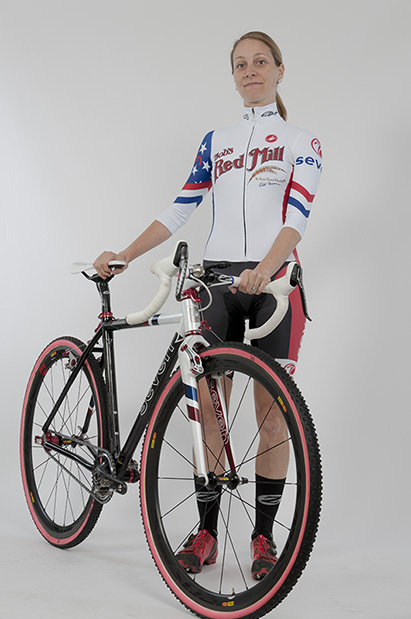
Seven-sponsored rider and good friend Mo Bruno Roy won the Single-Speed Cyclocross World Championship in Louisville on October 25th. We wrote about it first here. We had Mo and her MM Racing teammate/husband Matt Roy in the other day to talk about the race, where she is in her career, and what she wants out of riding her bike. This is what she said:
Seven: Did you believe you could win this race going in?
MBR: I was hoping I could. I was planning to, but I didn’t realize what it would take. Single-speed racing is full of shenanigans. People hand you bourbon shots and beers while you ride, and you can take shortcuts based on your willingness to engage in the fun. At Worlds you could skip the flyover if you chugged a beer. If you were willing to throw your bike over a four foot wall and climb over after, then you could avoid running through the sand pit.
At the start this year, none of us had shoes on. We had to slide down this giant slip n’ slide and then get on the bike and start racing.
Having said all that, I raced full gas the whole time, because honestly I didn’t know what was happening. There were racers everywhere, people I knew hadn’t passed me ended up in front of me. Maybe they cut the course. Maybe they found some other way. I took the hole shot at the beginning, and Matt says I had 30 seconds at that point, but then there were all these women in front of me. My plan had been to race hard the first two laps, and then relax and have some fun, but when I realized I wasn’t in front I went 100% to the line.
Matt: Don’t forget the feats of strength the day before. The whole thing starts the day before the race. They broke everybody up into groups of 15 led by a “colonel” who took the racers all over Louisville to stuff like a 100 meter cross course, a mass start hill climb on which you could score extra points by stopping to pick up a rubber chicken. There were trivia questions. All of it scored points to qualify for the race. It was just a big bunch of strangers roving the city in search of fun.
Seven: So it’s a whacky event. How does that make you feel about being World Champion?
MBR: The thing that is so attractive to me about Single-Speed Worlds is that there are very few rules. Ride a single-speed. Wear a costume. Don’t be a jerk. It’s just chaos, a bunch of really nice people having fun on bikes. I have taken racing seriously for a long time, and I needed to remember what it was like to have this much fun, so yes, I am totally proud of being World Champion. It also makes you appreciate the rules that govern the other elite races, that give those races structure. We complain about those a lot, but you can see what craziness takes over without that structure. I happen to be at a point in my career when I’m ready for some more craziness, so this is great for me, but I understand other people want to take it seriously. Honestly, this very well might be the highlight of my career.
Seven: This was all part of “taking it easy for the season,” but most people don’t associate World Championships, albeit whacky ones, with taking it easy. What is it you have really been trying to achieve in 2014?
MBR: World Cup racing is super hard work. You have to plan your whole life around it. There is so much expectation involved, and that ratchets down the fun level, or it changes it. You have fun, but it’s fun after you’ve finished, not right away. Sometimes it’s a long time after. So taking it easy, for me, means having fun WHILE I’m racing, actually enjoying each event, and single-speed races retain a part of the older spirit of cyclocross when events were weirder, and we were all less focused on results.
I think we need more of that spirit, and less of this sense that every race has to be pure and exclusive and elite. I have maybe been naive up until now, in thinking that bike racing was for everyone. Within the larger bike racing community we are more exclusive than I thought we were. So planning my season, I wanted to get back to a more open-minded approach to racing. I don’t think wealth should be a limiter, and that’s easy for me to say as a sponsored rider, but whether you show up on a mountain bike or need to zip tie your shifters to qualify for the single-speed race or whatever, we have to share this with as many people as we can. Honestly, if someone had suggested bike racing to me when I was a kid, there just wouldn’t have been any way, because we didn’t have any money, but cycling is really a community activity. We need to be drawing everyone into what we’re doing, and I don’t think there is any better way to do that than by making it fun, keeping it fun, and having that be our priority.
This isn’t some crusade for me to save bike racing. I’m just one person, but just like I ride a bike to work and to run errands, I can only try to be an example. As you get older, living your principles seems to become more and more important, so I’m happy with where I am and what I’m doing, and I hope it helps the communities that I live in, and either way I’m having fun, so it’s a win.

